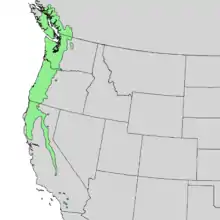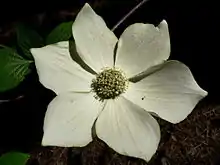Cornus nuttallii
Cornus nuttallii, the Pacific dogwood[1][2] or mountain dogwood,[2] is a species of dogwood native to western North America from the lowlands of southern British Columbia to the mountains of southern California, with an inland population in central Idaho. Cultivated examples are found as far north as Haida Gwaii. It is a small to medium-sized deciduous tree, reaching 10–25 m tall.
| Pacific Dogwood | |
|---|---|
 | |
| Scientific classification | |
| Kingdom: | Plantae |
| Clade: | Tracheophytes |
| Clade: | Angiosperms |
| Clade: | Eudicots |
| Clade: | Asterids |
| Order: | Cornales |
| Family: | Cornaceae |
| Genus: | Cornus |
| Subgenus: | Cornus subg. Cynoxylon |
| Species: | C. nuttallii |
| Binomial name | |
| Cornus nuttallii | |
 | |
| Natural range | |
| Synonyms | |
|
Benthamidia nuttallii (Audubon ex Torr. & A.Gray) Moldenke | |
Characters

The leaves are opposite, simple, oval, 8–12 cm long, and 5–8 cm broad. The flowers are individually small and inconspicuous, 2–3 mm across, produced in a dense, rounded, greenish-white flowerhead 2 cm diameter; the 4-8 large white "petals" are actually bracts, each bract 4–7 cm long and broad. The fruit is a compound pink-red berry about 3 cm diameter, containing 50–100 small seeds; it is edible, though not very palatable. They are eaten by band-tailed pigeon.[3]
Like the related Cornus florida, it is very susceptible to dogwood anthracnose, a disease caused by the fungus Discula destructiva. This has killed many of the larger plants in the wild and also restricted its use as an ornamental tree.
Cornus nuttallii is named after Thomas Nuttall, an English botanist and zoologist who worked in North America in the nineteenth century.
Some Plateau Indian tribes used the bark as a laxative and emetic.[4]
Government usage
It has been the provincial flower of British Columbia[5] since 1956.[6] It was once protected by law in the province (in an act which also protected Rhododendron macrophyllum and Trillium ovatum),[7] but this was repealed in 2002.[8]
Etymology
Cornus is the ancient Latin word for the Cornelian cherry, Cornus mas. 'Cornus' means 'horn'.[9]
Nuttallii is named for Thomas Nuttall (1786–1859), a grower of American plants at Rainhill in Lancashire, though he lived in Long Preston, Yorkshire.[9]
References
- "Cornus nuttallii". Natural Resources Conservation Service PLANTS Database. USDA. Retrieved 11 February 2014.
- "Cornus nuttallii". Calflora. The Calflora Database. 2014. Retrieved 12 February 2014.
- Peattie, Donald Culross (1953). A Natural History of Western Trees. New York: Bonanza Books. p. 655.
- Hunn, Eugene S. (1990). Nch'i-Wana, "The Big River": Mid-Columbia Indians and Their Land. University of Washington Press. p. 353. ISBN 0-295-97119-3.
- "Provincial Symbols and Honours Act". Queen's Printer British Columbia. Retrieved 2008-05-06.
- http://www.cic.gc.ca/english/games/teachers-corner/fact-sheet-british-columbia.asp
- "Dogwood, Rhododendron and Trillium Protection Act". Queen's Printer British Columbia. Archived from the original on 2002-01-02. Retrieved 2008-05-06.
- "Dogwood, Rhododendron and Trillium Protection Act". Queen's Printer British Columbia. Retrieved 2008-05-06.
- Gledhill, David (2008). "The Names of Plants". Cambridge University Press. ISBN 9780521866453 (hardback), ISBN 9780521685535 (paperback). pp 121, 275
External links
| Wikimedia Commons has media related to Cornus nuttallii. |